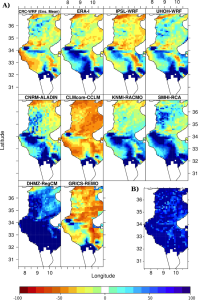l’article du mois – février 2018
 Errors and uncertainties in regional climate simulations of rainfall variability over Tunisia: A multi-model and multi-member approach
Errors and uncertainties in regional climate simulations of rainfall variability over Tunisia: A multi-model and multi-member approach
Fathalli Bilel, Pohl Benjamin, Castel Thierry, Safi Mohamed
Climate Dynamics in press
Temporal and spatial variability of rainfall over Tunisia (at 12 km spatial resolution) is analyzed in a multi-year (1992-2011) ten-member ensemble simulation performed using the WRF model, and a sample of regional climate hindcast simulations from Euro-CORDEX. RCM errors and skills are evaluated against a dense network of local rain gauges. Uncertainties arising, on the one hand, from the different model configurations and, on the other hand, from internal variability are furthermore quantified and ranked at different timescales using simple spread metrics.
Overall, the WRF simulation shows good skill for simulating spatial patterns of rainfall amounts over Tunisia, marked by strong altitudinal and latitudinal gradients, as well as the rainfall interannual variability, in spite of systematic errors. Mean rainfall biases are wet in both DJF and JJA seasons for the WRF ensemble, while they are dry in winter and wet in summer for most of the used Euro-CORDEX models. The sign of mean annual rainfall biases over Tunisia can also change from one member of the WRF ensemble to another. Skills in regionalizing precipitation over Tunisia are season dependent, with better correlations and weaker biases in winter. Larger inter-member spreads are observed in summer, likely because of (i) an attenuated large-scale control on Mediterranean and Tunisian climate, and (ii) a larger contribution of local convective rainfall to the seasonal amounts. Inter-model uncertainties are globally stronger than those attributed to model’s internal variability. However, inter-member spreads can be of the same magnitude in summer, emphasizing the important stochastic nature of the summertime rainfall variability over Tunisia.
- kc_data:
- a:8:{i:0;s:0:"";s:4:"mode";s:0:"";s:3:"css";s:0:"";s:9:"max_width";s:0:"";s:7:"classes";s:0:"";s:9:"thumbnail";s:0:"";s:9:"collapsed";s:0:"";s:9:"optimized";s:0:"";}
- kc_raw_content:
 Errors and uncertainties in regional climate simulations of rainfall variability over Tunisia: A multi-model and multi-member approach
Errors and uncertainties in regional climate simulations of rainfall variability over Tunisia: A multi-model and multi-member approachFathalli Bilel, Pohl Benjamin, Castel Thierry, Safi Mohamed
Climate Dynamics in press
Temporal and spatial variability of rainfall over Tunisia (at 12 km spatial resolution) is analyzed in a multi-year (1992-2011) ten-member ensemble simulation performed using the WRF model, and a sample of regional climate hindcast simulations from Euro-CORDEX. RCM errors and skills are evaluated against a dense network of local rain gauges. Uncertainties arising, on the one hand, from the different model configurations and, on the other hand, from internal variability are furthermore quantified and ranked at different timescales using simple spread metrics.
Overall, the WRF simulation shows good skill for simulating spatial patterns of rainfall amounts over Tunisia, marked by strong altitudinal and latitudinal gradients, as well as the rainfall interannual variability, in spite of systematic errors. Mean rainfall biases are wet in both DJF and JJA seasons for the WRF ensemble, while they are dry in winter and wet in summer for most of the used Euro-CORDEX models. The sign of mean annual rainfall biases over Tunisia can also change from one member of the WRF ensemble to another. Skills in regionalizing precipitation over Tunisia are season dependent, with better correlations and weaker biases in winter. Larger inter-member spreads are observed in summer, likely because of (i) an attenuated large-scale control on Mediterranean and Tunisian climate, and (ii) a larger contribution of local convective rainfall to the seasonal amounts. Inter-model uncertainties are globally stronger than those attributed to model’s internal variability. However, inter-member spreads can be of the same magnitude in summer, emphasizing the important stochastic nature of the summertime rainfall variability over Tunisia.
- extrait:
- lien_externe:
